London AGS Show, 2013
The previous week’s E. Lancashire Show having had been cancelled because of heavy snowfalls and blizzard conditions. The Met Office repeatedly instructed (did we actually need to be told!) that this was the coldest March for 50 years. And the London Show secretary issued a last-minute call for exhibitors to brave the weather and bring their plants. So it was with some trepidation that I entered the Lindley Hall. But I need not have worried, for the benches bore many wonderful plants in peak condition. Not quite as many, perhaps, as in recent years, and in the truth there were a good many classes with no entries, notably those for members of the Primulaceae, with primulas and cyclamen particularly few and far between, and dwarf Narcissus down in numbers too. But this dearth was to some degree compensated for by the number, range and quality of saxifrages on display, many having ‘held on’ longer than usual as a result of the unremitting cold weather.
As is usual at the London Show, a few exhibitors provided a great many of the plants, and its long most loyal and successful supporter was, once again, Cecilia Coller, who, I am delighted to record, reached the quite amazing milestone of 40 Gold Bars to her Gold Merit Medal at this Show. This figure represents no fewer than 2050 first prizes! Yet while lauding Cecilia for this astounding feat, we should not forget her octogenarian husband, Mervyn, who has carried many of the pots (often including heavy monsters for the six-pan and three-pan classes) into and out of the van, and then into and out of numerous halls all over the country, having made the long journey from Norfolk in between: we salute you both!
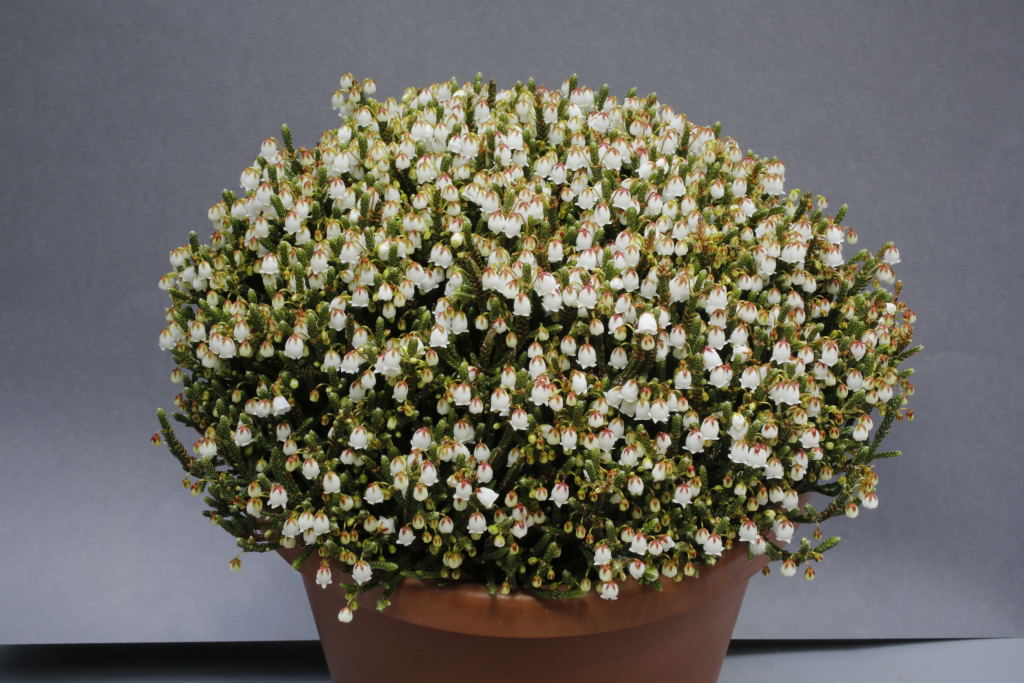
So what prizes and awards did Cecilia accrue? It almost goes without saying that she won the Mooney Cup for the most first prizes in the Open Section and the Anna Griffith Memorial Trophy for most first prize points. She also garnered the Royal Bank of Scotland Trophy for six plants distinct (see below), the George Gable Memorial Trophy for the best pan of Ericaceae (a superb plant evenly covered in flowers of Cassiope ‘Muirhead’, the more salutable considering that Cecilia lives in Norwich, not generally considered a favoured location for growing cassiopes), and the Farrer Medal for a splendid clump of the oft-admired Corydalis solida’ ‘Beth Evans’.
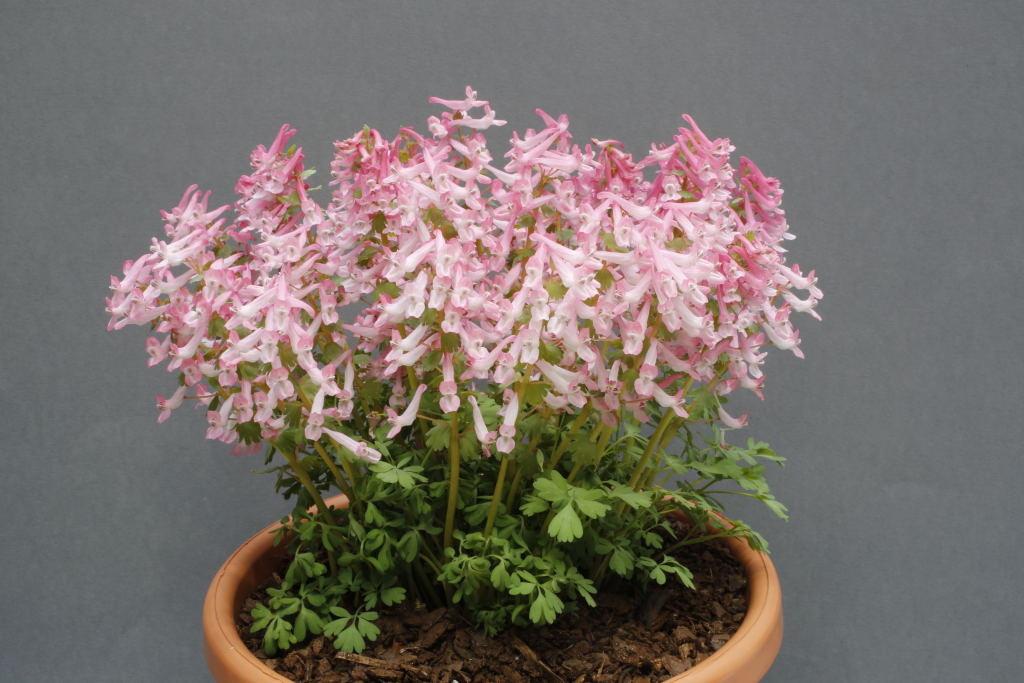
This was named for the wife of the rascally one-time Deputy Keeper of the Royal Botanic Garden in Edinburgh, Alf Evans, doyen of the peat garden in the days when to grow plants in peat and nothing else was regarded not as a heinous crime but as almost a necessity for ericaceous plants to be grown to perfection. There was discussion among the cognoscenti as to whether this was the ‘true’ plant: Corydalis are notorious for miscegenation and for dropping their seeds down to the base of the clump, where they germinate and may in due course in good faith be dug up and passed on as the original plant. If not the true plant (opinion was divided on this point), then as the late-lamented Irish comedian Frank Carson would have said, it was still ‘a cracker’.
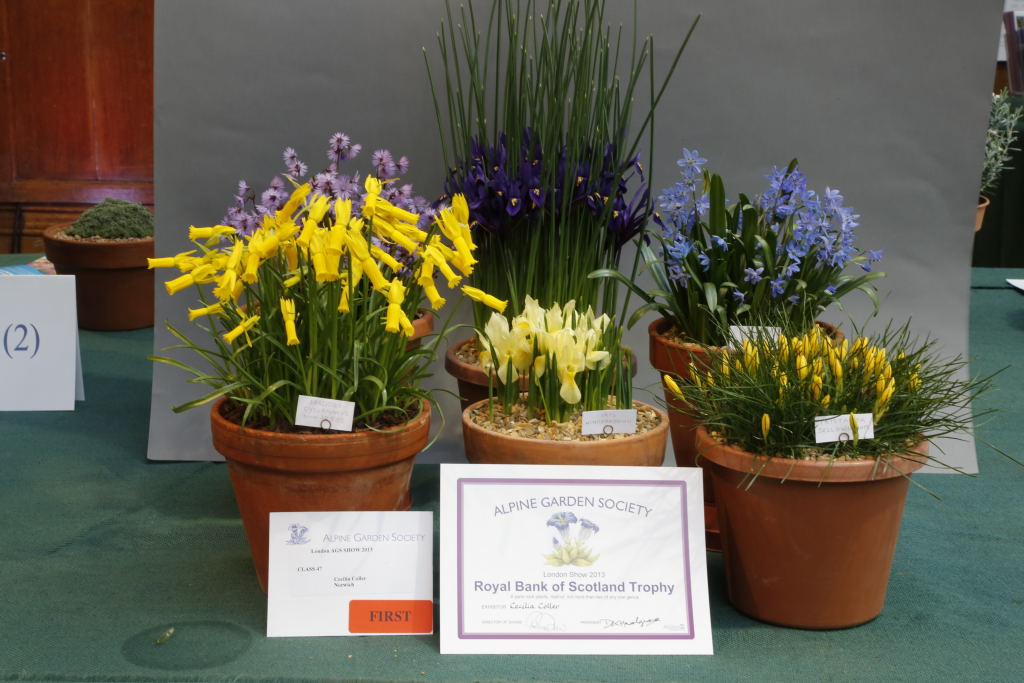
Cecilia’s RBS Trophy winning six-pan entry included a very good Soldanella carpatica, a species easy to grow but less so to flower well. The flower buds are formed in the autumn, but are hidden deep down in the crowns of the plant where they are very attractive to molluscs, and perhaps to other creepy-crawlies. Also, they are easily damaged by frost, which seems odd for the flowers of a plant that is a true alpine, until one remembers that soldanellas are classic snowbed plants, their buds covered by a protective blanket until spring arrives when they burst into life and push their way through the receding snow.
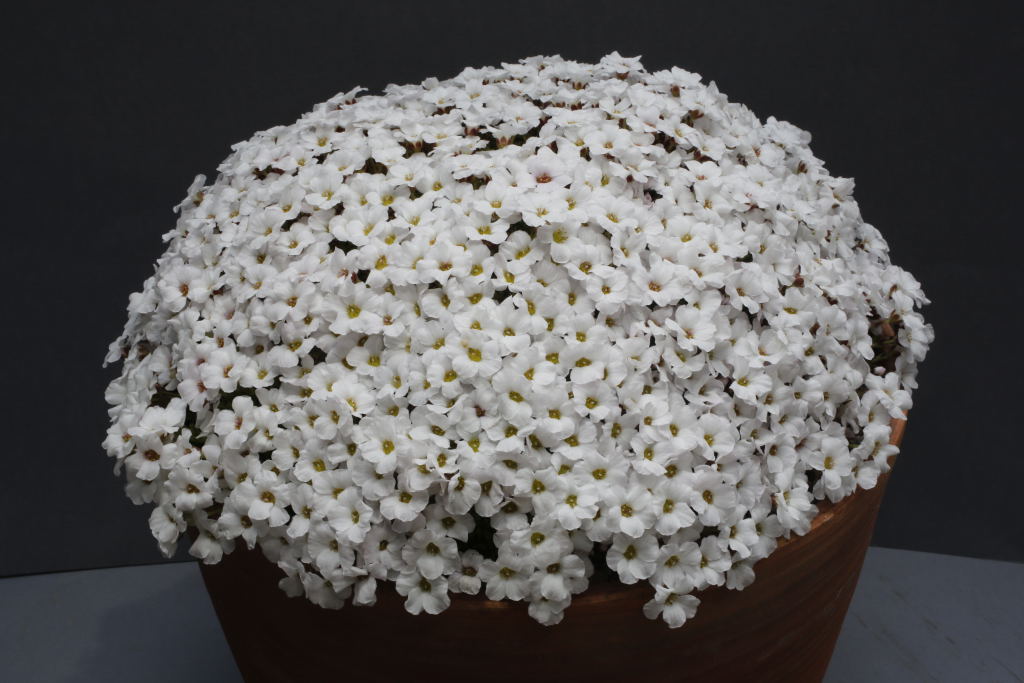
I mentioned earlier that cushion saxifrages were among the stars of this event, and the two finest, both in terms of size and floral perfection, each receiving a Certificate of Merit, were shown by David Hoare. Saxifraga ‘Tenerife’ (S. poluniniana x wendelboi) has pure white flowers, while those of S. ‘Cumulus’ (a S. iranica seedling) are flushed pink as they age. It should be noted that like most of their brethren, these Porphyrion saxifrages are often as good in the open garden as in pots, looking particularly at home in a tight crevice. The only snag is that they are easily scorched by hot sun if dry at the root, leaving unsightly dead patches, so it is generally best to site them where they will receive some shade in the hottest part of the day in midsummer.
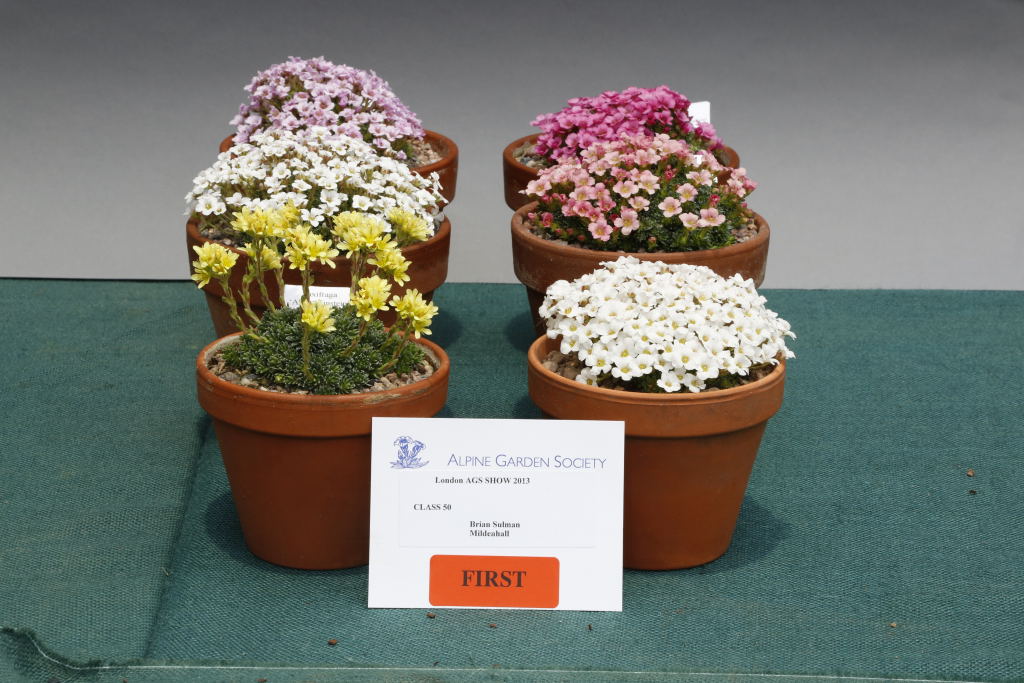
Keeping with these plants for the moment, Brian Sulman had a fine entry in a class for six pans distinct from any one genus. S. ‘Redpoll’ drew attention, its dark pink flowers with an even darker ‘eye’ emphasized by the ring of yellow anthers nestled within. Brian is to be complimented on providing very clear and informative notes for this exhibit, including sound guidance on cultivation, which will surely have been of interest to those aspiring to grow these plants to this standard.
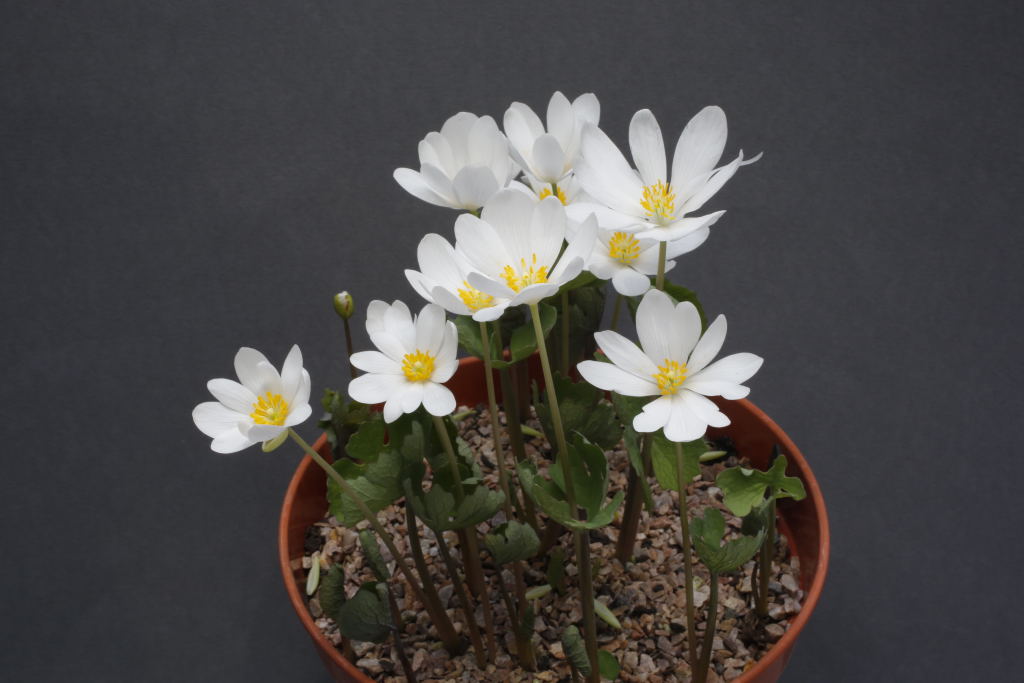
Joy Bishop, a stalwart supporter of the London Show for many years, exhibted a range of interesting and beautiful plants. Her perfect potful of the ephemeral, and therefore difficult to show bloodroot (Sanguinaria canadensis), won the Audrey Bartholomew Memorial Spoon for the best plant from N. America. We may bemoan the fact that the exquisite flowers of this woodland gem last for so short a time, or else celebrate their appearance each spring as a landmark of our gardening year. The bloodroot is an easy plant to grow in a semi-shaded spot with good leafy soil, through which it can push its thick fleshy runners that ‘bleed’ if they are damaged. Older gardening books suggested that if you divide this plant for propagation purposes you should staunch the flow of ‘blood’ with powdered charcoal or talc, but this anthropocentric approach is quite unnecessary. In my experience division is best done when the flowers shatter, with early autumn a reasonable alternative slot.
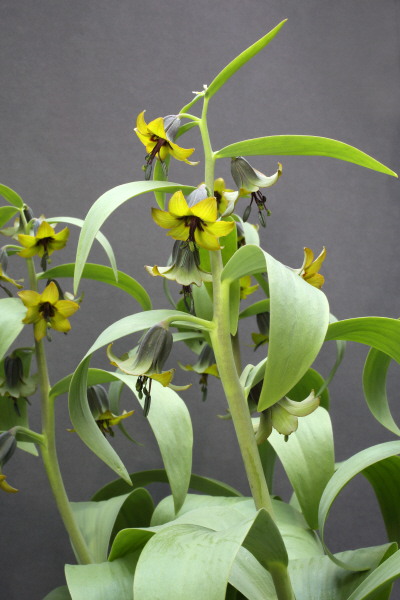
Another of Joy’s entries was a fine potful of Fritillaria sewerzowii, about 30 cm tall, which made an interesting contrast with a Lilliputian example of the same species a little further along the bench, shown by Cecilia Coller [below]. Discussion focused on whether this difference in height was due to cultivation, but surely it demonstrated once again the variability inherent within most plant species. I have not been able to grow this species outside in North Wales, probably because it is too wet both in summer and winter, but it is straightforward in a pot. Water should be withheld from when the shoots start to die back until late autumn.
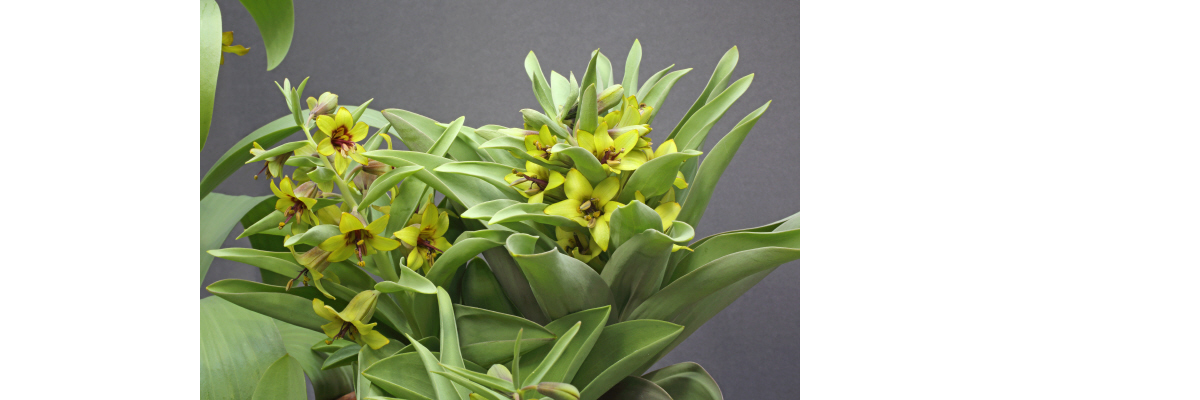
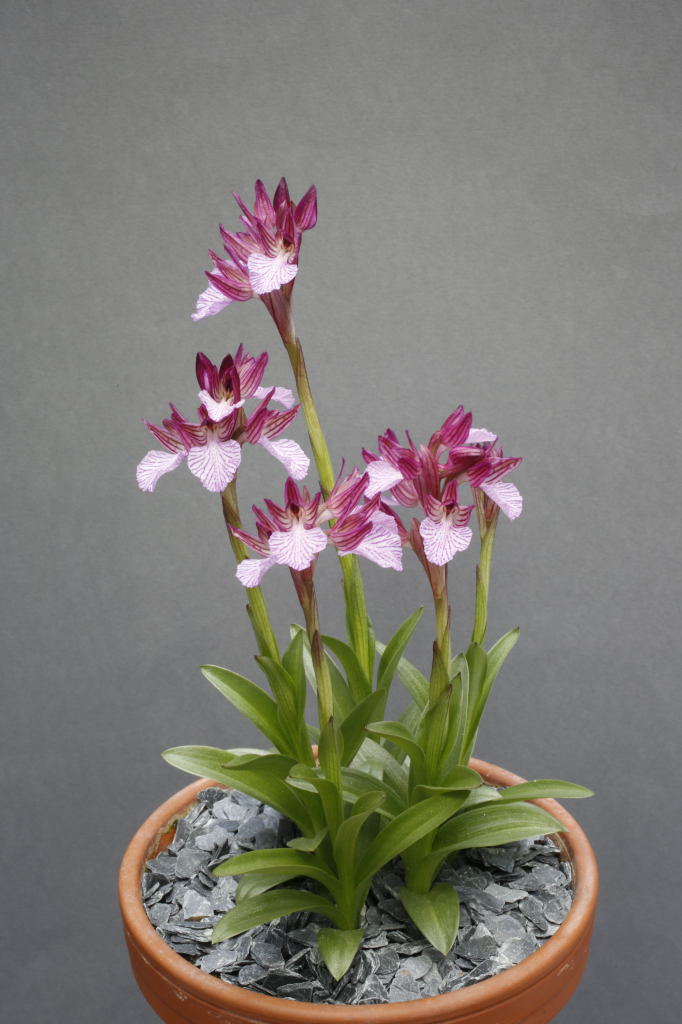
Think of first-rate orchid exhibits and the name Barry Tattersall comes immediately to mind. It’s not just that he brings so many rare and interesting orchids to the shows but also that the plants are invariably bursting with health and vitality. Others often find it difficult to retain good, healthy foliage when the plants come to flower, but through careful cultivation he has overcome this problem. Considered for best in show and awarded a Certificate of Merit was his impeccable Anacamptis papilionacea subsp. heroica (syn. Orchis papilionacea subsp. heroica). The separation of Anacamptis papilionacea into subspecies and/or variants seems pretty whimsical to me, but the grouping on the show bench looked very like many of the plants I drooled over on a trip to Crete last spring.
In the three-pan orchid class Barry put together a very interesting exhibit of three ‘tinies’, Orchis anthropophorum (syn. Aceras anthropophorum) [below centre], O. ichnusa (syn. Androrchis ichnusae) [below right], and Neotinea lactea [below left]. The Man orchid is widely found in continental Europe, though a rare native plant in the UK. It inhabits moderately sunny meadows on well-drained, often calcareous soil, also infiltrating moderate alpine areas. It is always fun to peer closely at the ‘little men’ dangling in clusters from the top of the flower stalk. The Sardinian orchid (Ichnusa is an old name for Sardinia) occurs on that island and Corsica in short, poor grasslands, garrigue and scrub at elevations up to 1500m. The flowers, usually 10 to 20 in number, are sweetly scented. Neotinea lactea (meaning ‘milky’, from the base colour of the flowers) is a familiar Mediterranean orchid, sometimes confused with other similar orchids. The example exhibited had typically white flowers heavily spotted with pink – they can be anything from clear white to deep pink.
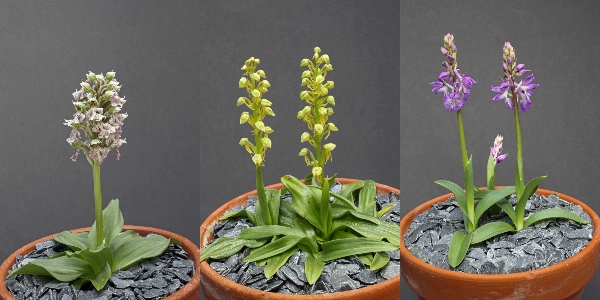
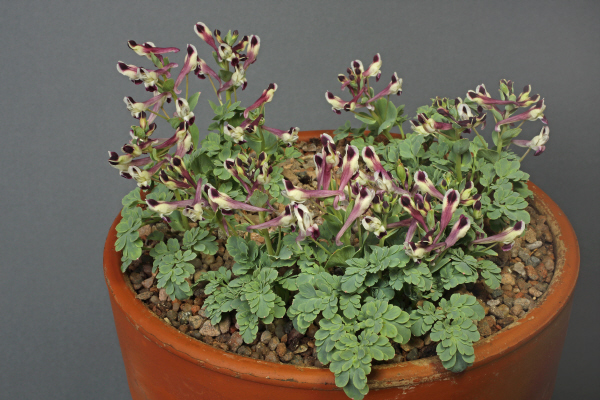
I said earlier that dwarf daffodils were in short supply at this show, but their dearth was somewhat compensated for by various other bulbs, including a number of other Corydalis in addition to those already mentioned. Michael Sullivan showed the rare, sweetly scented C. seisumsiana from Armenia's Zangezur Range. Once the foliage dies down, soon after flowering, the tuber should be kept dry through the summer. Apparently it has been grown successfully outdoors in the UK, but whether protected from overhead precipitation while dormant is not stated.
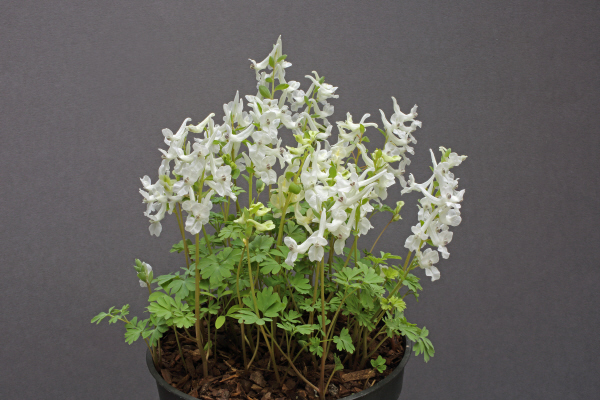
In a class for plants new in cultivation Ray Drew showed what was labelled ‘C. ? ( malkensis x bracteata)’. This had been grown from seed collected from a plant obtained as C. bracteata (but superficially a large, yellowish form of C. malkensis). The first flowers appeared after the third year, the resultant seedlings to all intents and purposes like long-racemed C. .malkensis. Most noticeable was a strong perfume, not normally a feature of this species, suggesting that it might be a hybrid. C. malkensis is known to hybridise freely with similar species and, being a tetraploid, contributes two-thirds of the genetic material into hybrids with diploid species, with hybrids very similar to the tetraploid parent. The combined features of the flower characteristics (whitish flowers with saccate lower petal) and entire (not lobed) bracts and spur shape suggested C. malkensis, perfumed, and long, slender racemes suggestive of C. bracteata, combined with the original mis-naming of the parent, backed the assumption of hybridity.
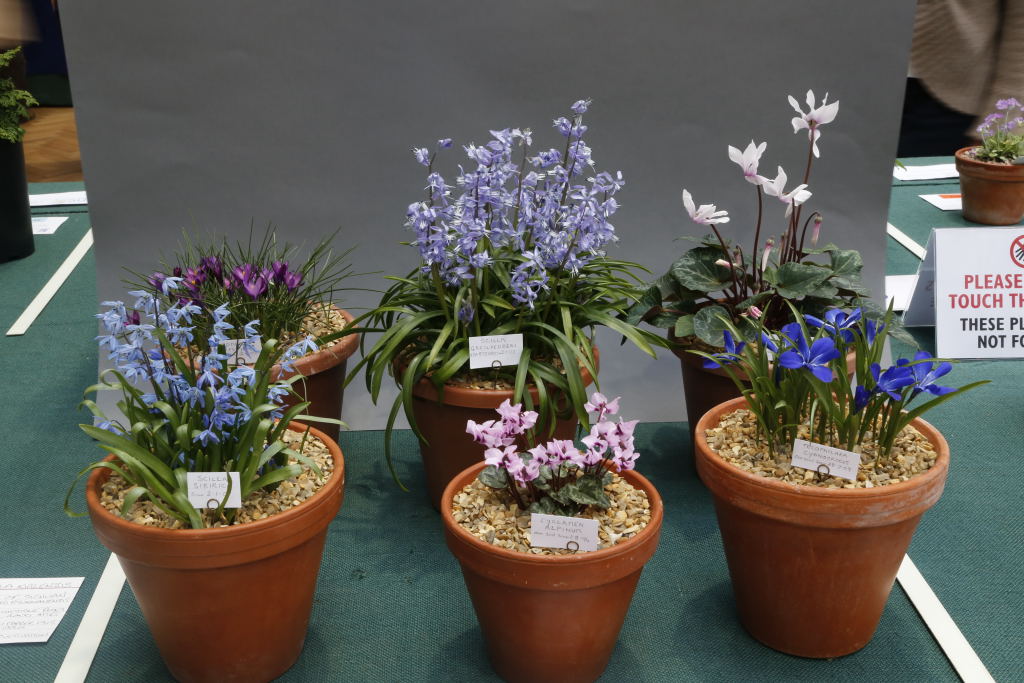
Scillas also contributed usefully to the bulbous component of this show with excellent examples of a number of species. In a class for three pans of bulbous plants Joy Bishop showed the outstanding, very dark blue S. ‘Norman Stevens’ and the softer S. melaina, while in her entry of six pans from seed, Cecilia Coller exhibited a much admired Jim & Jenny Archibald (JJA873.650) collection of S. greilheuberi (syn. Fessia greilhuberi). Although native to Iran it survives outside in Britain in semi-shaded areas that are dry in summer, for example among the roots of deciduous trees.
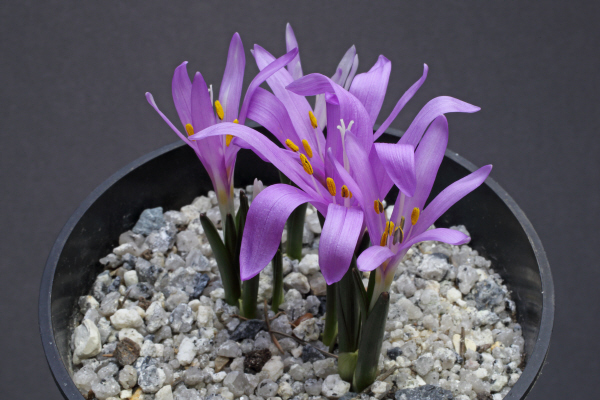
Brian Sulman’s excellent saxifrages have already been mentioned, and helped him to win the Tomlinson Tankard for the most first prize points in the Intermediate Section. Jean Noakes, who won the Henry Hammer Cup for the same distinction in the Novice Section, also exhibited some really good plants, including a nice pan of Bulbocodium vernum, which almost convinced us that spring really was only just around the corner!
It would be churlish to end this report without noting the awe-inspiring range of paintings, drawings, photographs and embroideries that filled enough display boards to provide a fine backdrop for the show benches, and more. It is invidious to single out particular exhibitors for mention, although show secretary Jon Evans not only put the exhibits together but also provided some of the best individual exhibits, while Jean Morris once again showed an exemplary collection of embroideries, securing the Muriel Hodgman Art Award for most first prize points in the Artistic Section. And my attention was drawn to a lovely photograph by Peter Maguire of Corydalis solida in a woodland setting, growing among the root buttresses of a venerable London plane – what more fitting exhibit could there be at a London Show?
Author: John Good
Photographer: Doug Joyce
